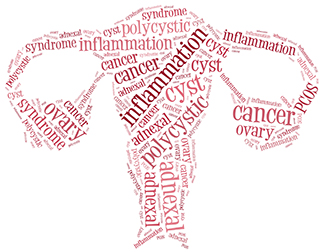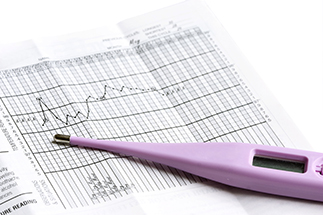Endometriosis and pregnancy

Endometriosis is a relatively common condition in women, but it is still not fully understood. During normal menstruation, the endometrial lining of the uterus (womb) builds up and is shed each month. Ideally, this lining is restricted to the womb but it can also grow in other areas of the pelvis. Growths of endometrial lining can appear on the ovaries, bowel, bladder, cervix and vagina as well as the fallopian tubes. It can affect up to 60% of women who complain of painful periods (dysmenorrhoea). Up to half of women who are diagnosed with endometriosis have trouble falling pregnant.
During ovulation these areas of endometrial tissue can also be stimulated because they are sensitive to hormonal influences. Without any means of being released from the body, collections of blood and fluid are retained, which causes patches of scarring and adhesions (abnormal tissue that binds organs together) to form.
This commonly leads to pelvic pain occurring both during the menstrual period and in-between. Painful intercourse (known as dyspareunia), bowel and bladder problems and infertility are other frequent symptoms.
Symptoms of endometriosis
There is a range of symptoms, which can be attributed to endometriosis. Some women have very distinct signs, while for others their symptoms are more vague. Depending on the stage of a woman’s menstrual cycle, e.g. during ovulation or menstruation, her symptoms may be more obvious.
- Very painful periods (dysmenorrhoea), which starts before your period and continues for a few days into your period
- Lower back pain and abdominal cramps
- Painful intercourse is a common sign of endometriosis
- Painful bowel movements or pain when peeing while you have your period
- Excessive bleeding – you may have occasional heavy periods and even bleed between your periods
- Infertility - Many women who are seeking treatment for infertility are diagnosed with endometriosis
- Other symptoms may include diarrhoea, constipation, bloating and nausea – especially during your periods
Because the symptoms of endometriosis can be so vague and mimic so many other disorders, having it correctly diagnosed can take some time. The associated bowel symptoms can mimic Irritable Bowel Syndrome (IBS) and the pelvic discomfort shares a similar pattern with Pelvic Inflammatory Disease (PID). For many women it’s not until they want to start conceiving and experience fertility problems that they learn they have endometriosis.
Diagnosis of endometriosis
Many women are in their mid to late twenties by the time they discover they have endometriosis, only because they are trying to fall pregnant and not because they complained of the pain. After all, periods are painful and we don’t always think that painful periods mean anything.
Up 24% of those women who complained of pain to their gynaecologists, were diagnosed with endometriosis – so if you have too much pain, speak to your gynae. Diagnosis is only made when the endometriosis can be seen during a laparoscopy or laparotomy. Samples of tissue are excised and sent to the laboratory for examination. If they are identified as endometrial cells then a formal diagnosis of endometriosis is made.
It is recommended that endometriosis should be considered in any woman of reproductive age who has pelvic pain.
How exactly does endometriosis cause infertility?
- Because the fallopian tubes are so small, almost microscopic in size, it does not take much for them to become blocked. Any interruption to the egg’s smooth passage along the tube reduces the likelihood of successful fertilisation.
- Developing thickened adhesions stops the egg from migrating along the tube and also the sperm from finding its way upwards and along the fallopian tube to the egg.
- Adhesions can also anchor the ovaries and tubes so they are misplaced from their normal position in the pelvis.
- Endometriosis can also “coat” the ovary, which inhibits the egg from being able to find its way into the tubes.
- Just as endometrial tissue in the womb produces blood, when this tissue is located on the ovary, menstruation occurs. Without having any means of escaping, this old blood forms into cysts on the ovary which further impact on normal ovulation.

- In some women there may also be an interruption to regular ovulation. If there are not as many eggs being produced and ovulation is irregular, then the overall chances of conceiving are reduced.
- Endometriosis may also have an influence on the quality of the eggs, so their chances of being fertilised and developing normally are reduced from the very start.
It’s worth remembering that not all women with endometriosis will be infertile. In fact, many fertile women have endometriosis; though only when scarring is extensive is there an impact on their fertility.
Many women with mild to moderate endometriosis will conceive without any difficulty and carry baby to term. Doctors (gynaecologists) often advise their patients to have children as soon as possible, since endometriosis may only get worse with age. It is still thought that endometriosis is one of the leading causes for female infertility.
What causes endometriosis?
There are many theories about what causes it, but there is no one definitive explanation. Here are some of the most widely believed theories:
- Retrograde menstruation – this is when the womb lining (called the endometrium) does not leave the body and instead flows up and into the fallopian tubes and into the tummy where it imbeds itself on the organs of the pelvis and grows.
- It’s always in the genes! It is believed that endometriosis is inherited.
- Endometrial cell transport. This theory believes that endometrial cells are transported to other parts of your body through the blood vessels or via the lymphatic (tissue fluid) system.
- Due to surgical scarring – it is believed that after a C-section or hysterectomy, the endometrial cells attach to the surgical incision site.
- Immune system problems – your body isn’t able to fight off endometriosis effectively; it doesn’t recognise the endometrial tissue that’s growing outside the womb and so doesn’t destroy it like it normally would.
How can I prevent getting endometriosis?
There is no way to prevent getting this condition. Genetics, individual factors and hormones can all have an influence, though ultimately there is no one known reason why it occurs. Some women experience problems from when they start menstruating. With the benefit of hindsight they can recall as teenagers having had debilitating pain during their periods, but just passed this off as normal experience.
Will falling pregnant fix my endometriosis?
No, this is a myth. It used to be thought that pregnancy was the cure-all for endometriosis, but this has been proven not to be the case. It is true that there is usually an improvement of symptoms and relief from endometriosis discomfort during pregnancy. In the majority of women, there is a recurrence of their endometrial symptoms within a couple of years after childbirth.
Treatment for endometriosis
There are a few options when it comes to treating endometriosis.
- Managing the pain and discomfort is only a temporary measure, but does not treat the cause or condition. Over-the-counter pain relievers (like ibuprofen) may be sufficient. These medications often act against the swelling caused by the condition. This alleviates the pain you feel. Alternately, pain relief medication, which is only available via prescription, may be required if the pain doesn’t go away.

- Another common treatment option is to take hormone-based treatments, which stops ovulation from occurring. Without oestrogen, the endometrial tissue is reduced and, as a result, pain is reduced. However, this does not improve your fertility, and may not be the choice you go for if you want to have a baby.
- Surgery, like laparoscopy, laparotomy or hysterectomy, is another treatment option.
- Where possible, it is done via keyhole surgery (laparoscopy), which is the most commonly used and least invasive technique. In this procedure, the surgeon uses a laser to excise the endometrial cells where they have collected. This type of surgery can relieve your symptoms and improve fertility, however symptoms can return, especially if any of the endometriosis tissue has been left behind.
- A more invasive procedure is the Laparotomy. It is only used if endometriosis is severe or if it has caused some of your organs to grow together. Even though the procedure is similar to a laparoscopy, the cut is bigger and the laser is replaced with a scalpel. Removing endometrial tissue from the pelvis and organs requires skill and precision and is not without risk. Any operation carries a chance of complications; though for many women, having a chance of reducing their pain and increasing their chances of conceiving is worth it.
- In women who have completed their families and whose lives are being affected by endometriosis, hysterectomy is another option. This should only be considered as a last resort when the pain and symptoms of endometriosis are impacting significantly on every day functioning.
Things to remember
If surgery is not successful, in vitro fertilisation (IVF) may become the only realistic option to assist with conception. For all its inconveniences and pain, it is worth noting that endometriosis, in itself, is not life threatening.
For more information:

